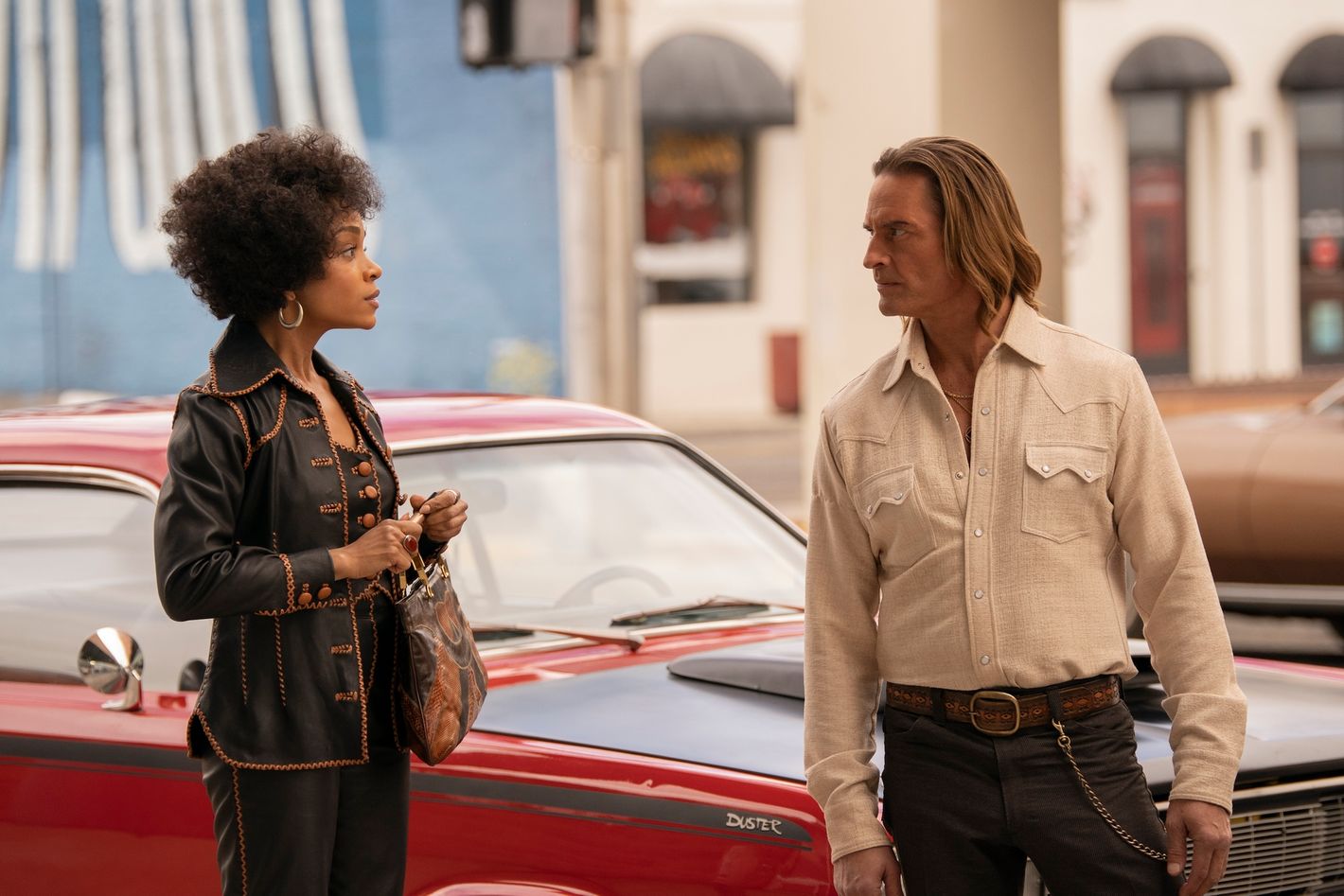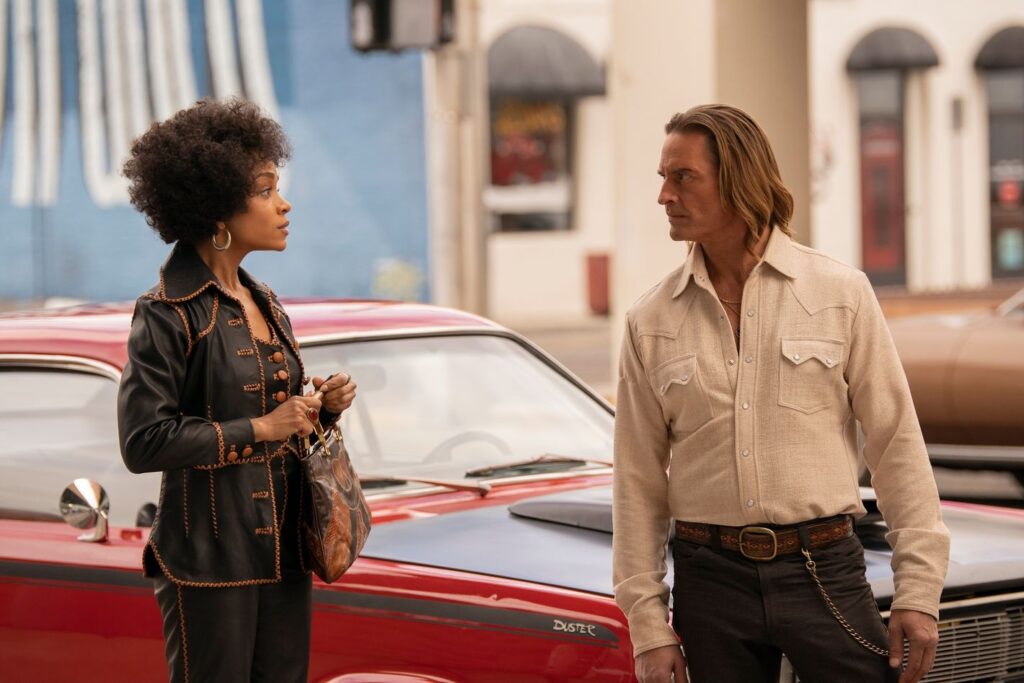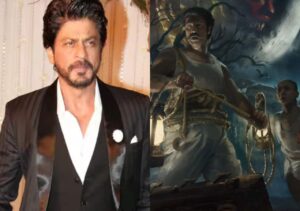
In the immortal words of Jesse Gemstone, sometimes you just want to do “car pranks” with your friends. This is what we were promised with Duster, the ’70s-set crime series co-created by LaToya Morgan and J.J. Abrams, starring Josh Holloway of Lost, and named for Holloway’s character’s muscle car. It is also not what Duster, a series whose narrative reach quickly exceeds its storytelling grasp, delivers.
Sure, there are intermittent car chases throughout the series’s eight episodes, and Holloway’s Vietnam vet–turned-mobster does a lot of smirking and leaning against his ruby-red Plymouth. But watching Duster’s first season, which premieres on (HBO) Max tonight and airs weekly, is akin to missing your exit because your maps app gave you the wrong directions, so you crank a U-turn, then you miss your exit again, and then you drive around in circles because you’re totally lost. Duster surrounds itself with the throwback aesthetics of the era’s episodic series like Charlie’s Angels and Starsky and Hutch, but it’s not happy being just a throwback. (It’s not dissimilar from the ’70s-set John Wick prequel The Continental that way.) It wants to be more — more mysterious, more complicated, more feminist, more inclusive — and those impulses move Duster further and further away from any lizard-brain entertainment value it may have had. The imbalance of those component parts results in Duster feeling like one long prequel to the story Morgan and Abrams want to eventually tell, possibly in a second season, instead of a collection of episodes that stand on their own terms. If a series ever needed a binge drop to maintain viewer interest, it’s this one. And if a series ever needed an overarching conspiracy less, it’s also this one.
Set in the early 1970s, some time after long-term FBI director J. Edgar Hoover’s death and during President Richard Nixon’s second term, FBI agent Nina Hayes (a game Rachel Hilson, trying to turn a collection of girl-power clichés into a character) arrives in Phoenix with a specific target in mind. For personal reasons you can probably deduce, Nina has it out for organized-crime boss Ezra Saxton (Keith David), whom she realizes is working on a bigger score than his typical gun-running and racketeering. To get into his organization, she needs a confidential informant, and she lures his driver Jim Ellis (Holloway) into that position with her theory that Ezra actually assassinated his brother, Joey, who also worked for the family. Nina’s challenge is twofold: to get Jim to trust her enough to provide usable intel on Ezra, and to gain the respect of her FBI colleagues, most of whom treat her like an aberration or an inconvenience. (Yes, Abrams’s recurring guy Greg Grunberg is here as one of those FBI naysayers.)
Where Nina’s characterization is thin, Jim’s is broad — and hampered, almost irredeemably, by the fact that 55-year-old Holloway is playing a character who is written as being in his 30s. That’s not to diminish Holloway’s incredible moisturizing routine, his perfect wavy TV hair, or the seductive power of his dimples. But Jim isn’t a Cool Guy ever-so-slightly past his prime and wondering what he’s going to do with his life (like, say, Cliff Booth), a portrayal that would at least make his relationship with Nina, and his second chance at relevance through CI work, feel more understandable. Instead, Jim’s a ladies’ man fairly unbothered by his time serving in the Vietnam War, and he’s also craving more responsibility from Ezra, and he’s also trying to forge a relationship with his young daughter, and he’s also butting heads with his father’s new wife, and he’s also mourning Joey, also also also. Duster keeps layering character details on Jim but doesn’t allow Holloway much time for introspection as it increasingly devotes screen time to a scattered scheme in which Jim and Nina are only ancillary players. And it also doesn’t let Jim be enough of a badass to ground that sprawl in the heists, shootouts, and other physical dangers you’d expect from this genre. What Duster offers more than anything else are slow-motion sequences of characters walking around in period clothes to contemporaneous songs or nods to period films like Butch Cassidy and the Sundance Kid and The Godfather, but homage is about the extent of this series’s attempt at style.
Despite Morgan’s co-creator status and her four episodic writing credits, what Duster primarily reveals itself to be is an attempt at recapturing the magic of Abrams’s early days in television: the women-kicking-ass flavor of Alias, the puzzle-piece intricacy of Lost, the coming-of-age charm of Felicity. But Duster can’t pull off those series’s slow-burn plots in only eight episodes, nor is its action propulsive enough to immerse us in escapism. By the time a certain infamous American eccentric shows up as a family friend of Jim’s and the final scene teases another villain down the line, you’ll wonder why this series was so intent on setting up a possible renewal that it skimped on establishing itself on its own terms. Turns out the only real car prank Duster can pull off is spinning its wheels.
If a series ever needed a binge drop, it’s this one. And if a series ever needed an overarching conspiracy less, it’s also this one.

































































